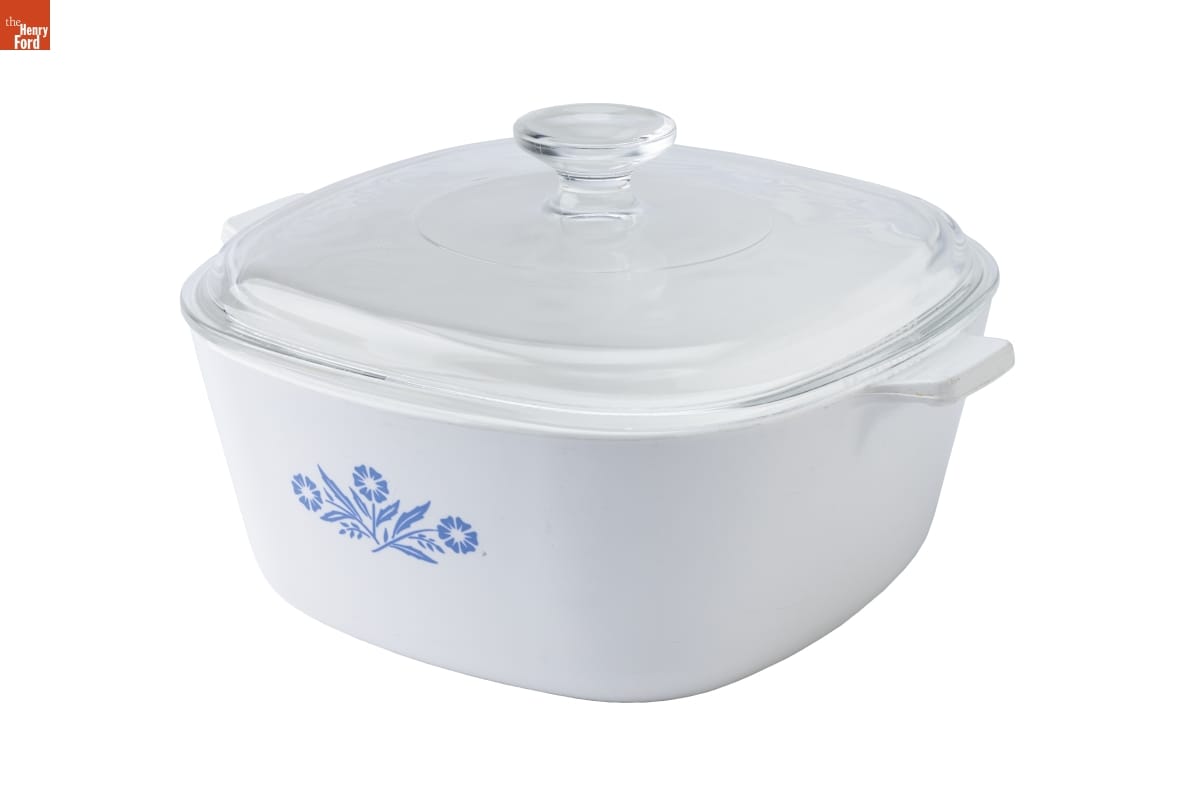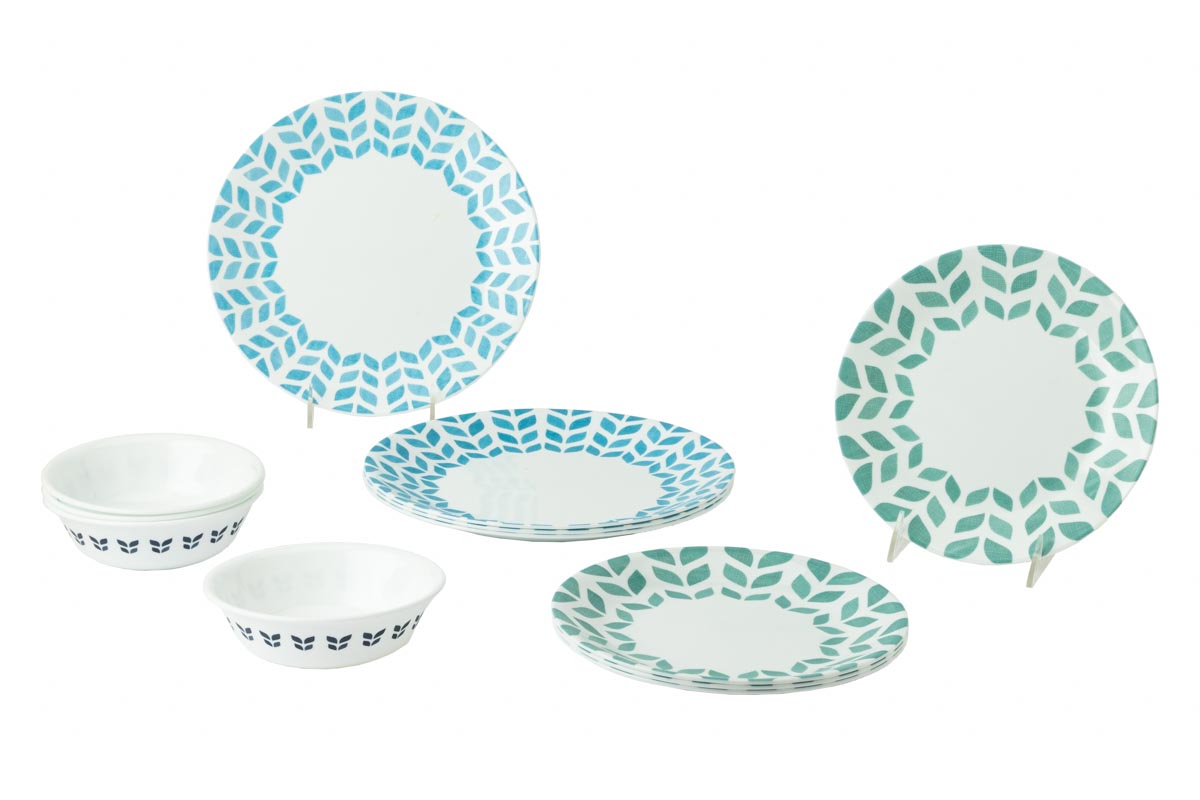Pyrex, Corning Ware and Corelle: Enduring Kitchen Icons from Corning
Three brands developed by Corning Glass Works during the 20th century — Pyrex, Corning Ware and Corelle — became household names that revolutionized American kitchens and endured decades of changing consumer tastes and expectations.

Corning Glass Works found both industrial and household applications for Pyrex. The company produced Pyrex insulators and laboratory glassware alongside its increasingly popular ovenware in the 1930s. Pyrex Perfect Antenna Insulator, 1930-1939. / THF174626
In 1908, scientists at Corning developed glass that could withstand extreme temperatures. It was initially used for industrial products like railroad lanterns and battery jars. Hoping to broaden the market, Corning spent years testing possible household applications. Encouraged partly by the success of one notable experiment — when Bessie Littleton, whose husband was a Corning researcher, used a modified glass battery jar to bake a cake — Corning introduced Pyrex, a line of temperature-resistant glass cookware. The launch of Pyrex in 1915 inaugurated a new Corning division dedicated to consumer products.

This early advertisement for Pyrex ovenware touts its many advantages. National Geographic, 1916. / THF709296
Pyrex bakeware entered the market at an advantageous time. In the early 20th century, the principles of scientific management — used in industrial settings to improve efficiency — found their way into the kitchen. Transparent Pyrex ovenware fit the bill — it performed well, was easy to clean and could go from oven to table. The Pyrex line was expensive at first — marketed initially to women of means interested in up-to-date products.

Pyrex Flameware Percolator, 1939-1951. / THF191912
Pyrex’s excellent performance in baking was unquestionable. Yet, to become a greater contender in the cookware industry, Pyrex would need to be usable for top-of-stove cooking on an open flame. The introduction of Pyrex Flameware in 1936 added this feature, increasing the product’s appeal. Too, changes in manufacturing helped make Pyrex more affordable by the 1930s.

Corning Ware Casserole Dish, 1960-1961. / THF192899
Next up? The accidental discovery of a new material — glass-ceramic — by a Corning research chemist in 1952. The gleaming white opaque material could withstand extreme cold and heat and didn’t break when dropped. First used in nose cones for radar-guided missiles, this new material found its way into the kitchen in 1958 as Corning Ware — a line of innovative, shatterproof cookware that could go right from the freezer to the oven or range and then to the table as a serving dish.

Corning advertisement, 1968. / THF710401
Versatile, durable, attractive and affordable, Pyrex and Corning Ware became staples in American kitchens.
Color and More

Pyrex Primary Colors Mixing Bowl Set, 1949-1957 and three Pyrex Primary Colors Refrigerator Dishes with Lids, 1947-1960. / THF167736, THF176489, THF176490 and THF176488
By the late 1940s, Corning sought to appeal to evolving post-World War II tastes with a focus on the center of the American home — the kitchen. Continuing the trend toward enlivening kitchens with new products in vibrant choices, Corning transformed Pyrex from colorless to colorful with the “Primary Colors” line, introduced in 1947. Customers could mix and match sets of cookware that were practical and functional but also stylish.

Cornflower Pattern Percolator, Teapot and Platter 1960-1961. / THF370218, THF370237, THF191905
Corning applied a similar styling approach to its revolutionary Corning Ware line. The popular Cornflower Blue pattern, introduced in 1958, became synonymous with Corning’s brand identity. It appeared on all sorts of products — most famously on casseroles but also on percolators, teapots and platters. Consumers could buy pieces as needed and eventually collect a color-coordinated set of cooking and serving ware. Later patterns reflected new trends and helped broaden the market for Corning Ware.

This Corning Ware brochure shows patterns available in 1987 — Shadow Iris, Pastel Bouquet, Spice O’ Life and the iconic Cornflower Emblem — as well as the now-classic French White line of casseroles. / THF709300
Revolutionizing the Dinner Table

Corelle Livingware cups and saucers in Butterfly Gold, 1971. / THF195008, THF195009, THF195011
Unlike Pyrex and Corning Ware — products made of new materials created without a singular purpose in mind — Corning deliberately pursued another kitchen innovation in the 1960s. The company thoroughly researched consumer preferences in dinnerware and then set to work on improving it. A breakthrough came in 1965 when a Corning scientist developed a laminating technique that produced very thin, yet very strong glass. Corning introduced Corelle Livingware, dinnerware made from this light and durable layered glass, in 1970.

Corelle Livingware dinnerware set in Spring Blossom Green, 1971. / THF195020
Corelle was a radical departure from the past, where expensive dinner sets consisted of many pieces, including luncheon plates and soup and salad bowls. By contrast, the first Corelle Livingware service consisted of a set of four large plates, four medium bowls, and four cups and saucers, retailing for the attractive price of $19.95. In addition, Corning provided a two-year guarantee to replace any piece that broke.
Corning’s savvy marketers compared Corelle to fine china. Product packaging with the slogan “looks, feels, and rings like china” depicted a mother “pinging” a Corelle plate. The company also offered consumers a selection of fashionable patterns. Pieces from the debut collection featured Butterfly Gold, Spring Blossom Green, Old Towne Blue and Snowflake Blue designs around the rim. Corning’s greens and golds were variations of the Harvest Gold and Avocado Green color schemes iconic of the late 1960s and early 1970s.
Corelle was incredibly successful and changed middle-class American dining habits — it was chic yet durable and inexpensive enough for casual use. Corelle frequently sold out and was back-ordered throughout the 1970s. Corning continually added new “lifestyle” patterns and discontinued old ones to keep up with the latest decorative trends.
Still the Standard

Corning Pyrex FreshLock Plus food storage set with Microban antimicrobial product protection, 2022. / THF195359
Corning continually updated its Pyrex, Corning Ware and Corelle lines with new products that retained the qualities that had made them household names. The company sold its housewares division in 1998, but all three brands remained staples of American kitchens. In the 21st century, updated variations and marketing approaches appealed to changing tastes and lifestyle trends. Sets of Pyrex dishes designed for cold storage, portability and easy reheating featured locking plastic lids with odor-preventing technology. Marketers imagined new uses for classic Corning Ware, even designating some iconic French White casseroles as official companion pieces for the cult favorite Instant Pot brand of multicookers. (The company that manufactured Corning housewares merged with Instant Brands in 2019.) Continually updated Corelle patterns appealed to contemporary tastes.

Corelle Livingware dinnerware set in Northern Pines, 2022. / THF195362
Durable, convenient and stylish, the iconic brands developed by Corning in the 20th century continue to have relevance in today’s kitchens.
Charles Sable is curator of decorative arts, Jeanine Head Miller is curator of domestic life and Saige Jedele is associate curator at The Henry Ford.
glass, by Jeanine Head Miller, by Charles Sable, 20th century

